How Does a Changeover Switch Enhance Power Management and Improve Operational Efficiency?
2025-02-21
In today’s world of continuous power demands and the need for reliable electricity, how can a changeover switch help ensure seamless transitions between power sources, preventing costly downtimes and improving operational efficiency? What exactly does this crucial electrical device do, and why is it so essential for both residential and industrial settings?
Understanding the Role of a Changeover Switch
A changeover switch is an electrical device that enables the switching of power between two different sources, ensuring a smooth transition without any interruption to the power supply. This is especially important in settings where an uninterruptible power supply (UPS) is critical, such as in hospitals, factories, data centers, and residential properties with backup generators.
Essentially, a changeover switch acts as a control mechanism that automatically or manually switches the load from one power supply to another. For example, if there is a power outage, a changeover switch allows for the seamless transfer of electricity from the utility grid to a backup generator. This prevents downtime and ensures that operations continue without disruption.
Why Is a Changeover Switch So Important?
1. Ensuring Continuous Power Supply
One of the main reasons for using a changeover switch is to ensure that there is no interruption in the power supply. In the case of power outages or fluctuations in the electrical grid, a changeover switch automatically or manually switches to a backup power source, such as a generator, within seconds. This continuity of power is critical in environments where even a brief loss of power can result in significant losses, whether in industrial production, healthcare, or business operations.
2. Reducing Risk of Equipment Damage
Without a changeover switch, the process of manually switching between power sources can cause surges or outages, potentially damaging sensitive electrical equipment. A properly installed and maintained changeover switch ensures a safe transition, minimizing the risk of electrical faults, and thus protecting machinery, appliances, and other valuable assets.
3. Improved Safety and Convenience
In the past, manual switching of power sources required operators to perform the switch physically, often putting them at risk of electrical shock or making mistakes during the process. With an automatic changeover switch, the process is done remotely and safely, ensuring that operators don’t need to interact directly with the electrical equipment during a power transition. This improves both safety and operational convenience.
4. Automatic vs. Manual Changeover Switches
There are two main types of changeover switches: automatic and manual. Automatic changeover switches (ATS) detect a power failure or fluctuation and immediately switch to the backup power source without human intervention. Manual changeover switches, on the other hand, require an operator to manually switch between the power sources. While ATS is preferred for critical applications due to its speed and hands-off operation, manual switches are often used in smaller setups or situations where the backup power is not required to kick in immediately.
Common Applications of Changeover Switches
1. Residential Use
In homes with backup generators, a changeover switch is essential to ensure that the home can seamlessly switch from the utility grid to the generator during a power outage. This allows homeowners to maintain power to essential appliances, such as refrigerators, heating or cooling systems, and medical equipment, without having to manually switch over to backup power.
2. Industrial Settings
In industrial environments, where machinery and production lines rely heavily on consistent power, a changeover switch ensures that operations don’t halt during a power failure. Changeover switches are used to manage the transition between the main power grid and backup generators, ensuring that essential operations continue without delay. This minimizes downtime and keeps production running smoothly.
3. Healthcare Facilities
Hospitals and healthcare facilities are some of the most critical environments where a constant power supply is essential. A changeover switch allows these facilities to seamlessly transition from the main grid to backup power sources, ensuring that life-saving equipment, such as ventilators and monitors, continues to function during an outage.
4. Data Centers
For data centers, where uninterrupted power is vital to maintain operations, changeover switches help ensure that servers, networking equipment, and other infrastructure receive constant power. Without a reliable system in place, data centers risk losing data or incurring costly downtime. The automatic transfer mechanism of an ATS ensures that there is zero disruption in service.
What Should You Consider When Choosing a Changeover Switch?
1. Size and Load Capacity
The size and load capacity of the changeover switch should match the power requirements of your electrical system. Whether you need a changeover switch for a small residential system or a large industrial facility, choosing the correct size will ensure it can handle the electrical load and prevent overloads.
2. Switch Type
Depending on your needs, you may want to choose between an automatic or manual changeover switch. For high-demand or critical systems, automatic switches are preferred, as they ensure immediate and error-free switching. For smaller applications, a manual switch may suffice.
3. Safety Features
It is important to consider the safety features of a changeover switch. Look for devices that are certified by relevant safety standards and have features such as overload protection and grounding to protect against electrical hazards.
4. Ease of Installation and Maintenance
A changeover switch should be easy to install and maintain, especially in commercial or industrial settings where downtime can be costly. Opt for switches that are designed for easy installation and require minimal maintenance.
Conclusion
So, how does a changeover switch enhance power management and improve operational efficiency? By ensuring that the transition between power sources is seamless and automatic, changeover switches play a crucial role in preventing downtime and protecting valuable equipment. Whether it’s used in residential, industrial, or critical healthcare settings, a changeover switch offers reliability, convenience, and safety in power management, helping both individuals and businesses maintain continuity in the face of unexpected power disruptions.
In an increasingly power-dependent world, the importance of having an effective changeover switch cannot be overstated. It’s not just a component of electrical systems; it’s a key player in ensuring that operations continue smoothly, safely, and without interruption.



